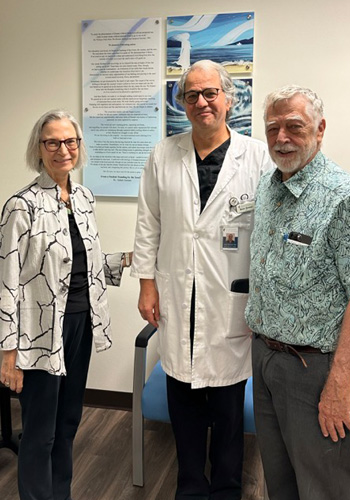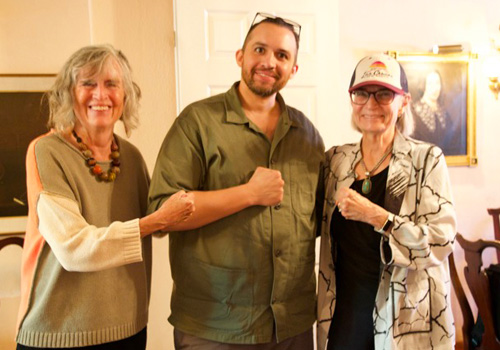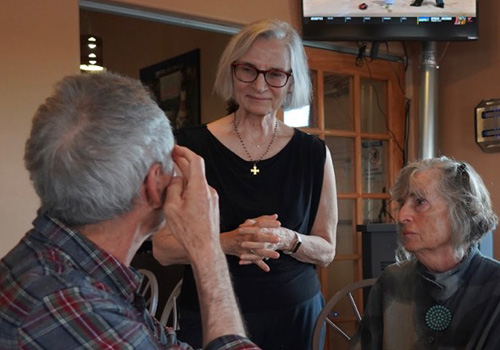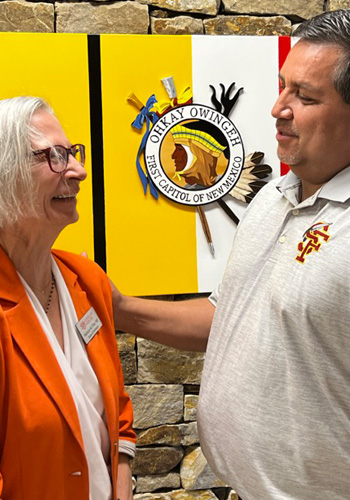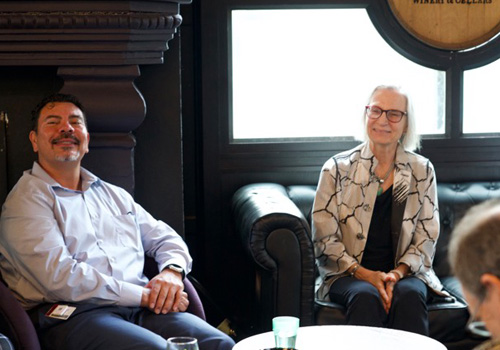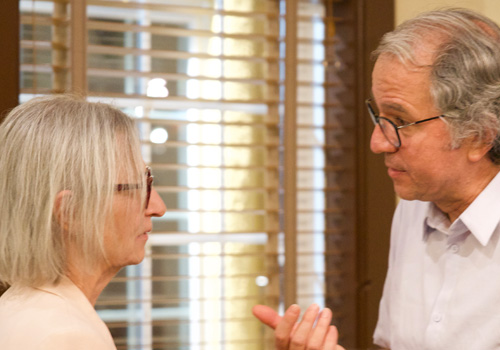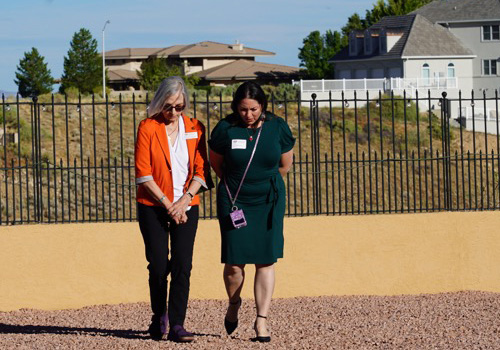Off Duty UNM Hospital Employees Save a Bicyclist’s Life on the Bosque Trail
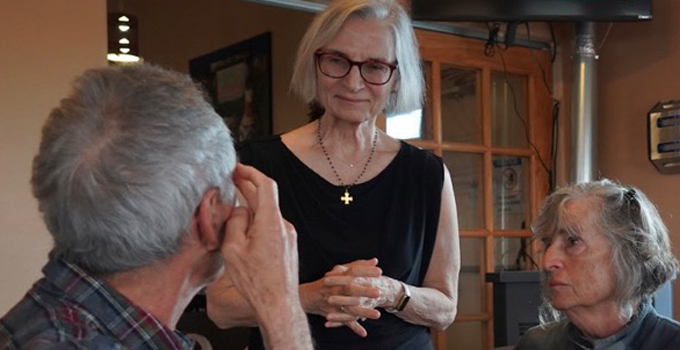
UNM School of Medicine Dean Listens to NM’s Communities to Plan Next Steps
It’s one thing to teach health equity from a classroom. It’s an entirely different thing to experience it, being embedded within New Mexico’s communities. For that reason, the dean of The University of New Mexico’s School of Medicine, Patricia Finn, MD, crisscrossed the state with the sole intention of truly listening to what New Mexicans had to say.
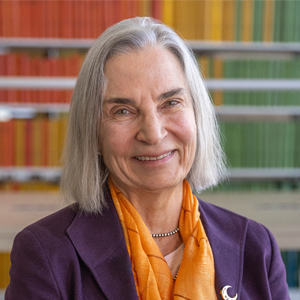
I have a lot to learn, and I'm inhaling it. I wanted to know where we are geographically, culturally, spiritually and just as people. So, I thought the best way was to do it in person.
“I am brand new to my position as the dean of the School of Medicine, which serves all of New Mexico” Finn said. “I have a lot to learn, and I'm inhaling it. I wanted to know where we are geographically, culturally, spiritually and just as people. So, I thought the best way was to do it in person.”
As a dean, academics, research and student success are top priorities, but creating health equity is also a passion that Finn said innately comes from who she is as a person.
“It comes from my upbringing and my DNA,” Finn said. “I'm a first-generation Irish immigrant. My parents never had a formal education or passed third grade. They spoke with accents so thick you could not understand them, but they had this sense of, ‘Everybody gets a shot.’”
Finn came to New Mexico from the Midwest, where she was chair of Medicine, associate dean for Strategic Initiatives and associate program director for the Medical Scientist Training Program at the University of Illinois College of Medicine in Chicago. She sees health equity as her purpose.
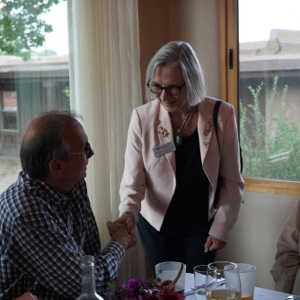
Medicine is a calling. Being here, in New Mexico, at this time to really provide opportunities at the highest level for human beings -- that is what we can do, what we should do, and we will be able to do.
“Medicine is a calling,” Finn said. “Being here, in New Mexico, at this time to really provide opportunities at the highest level for human beings -- that is what we can do, what we should do, and we will be able to do.”
In August, she hit the road traveling to Farmington, Taos and Gallup in northern New Mexico and Las Cruces, Roswell and Ruidoso in southern New Mexico. Finn’s husband, David Perkins, MD, PhD, who co-leads the MD/PhD program in the UNM School of Medicine, joined her along with others from UNM Health Sciences. Throughout the trip, Finn had discussions with UNM alumni, students, faculty, providers and legislators. She also visited pueblos and Indian Health Service clinics .
“We spent a lot of time dissecting and interacting,” Finn said. “Whenever we went anywhere, I would go to the left side, my husband would go to the right side. I needed to know where things were, what they were, and I really want to be responsive. We have four missions: education, clinical, research and our commitment to our local and global community. I didn't feel I could fulfill those unless I had some sense of who was there.”
It was important to Finn to meet with alumni and mentors throughout New Mexico, to talk about their work and hear about what matters to them.
“They are faculty members affiliated with us. They teach our students. We honor them and I wanted to make sure they felt that the dean was there. We have a number of students in rotations; I also wanted to see how it was going for them.”
Interacting with legislators and donors was also a top-of-mind goal.
“I wanted to ensure that I understood what legislators think is important for their constituency and for their people as we fight for overall improvement of health care,” Finn said. “Similarly, for donors who had contributed, I wanted to thank them in a meaningful way, but also to learn what is important to them and what are the areas that we can enhance.”
Finding the bright side and celebrating success stories
Once on the road, Finn said she was met with people who left her moved, inspired and determined.
“Each visit was an adventure, thrilling, exhilarating, meaningful and humbling. I was blown away with the warmth and excitement.”
Finn talked about meeting with one of the few orthopedic surgeons practicing in Roswell, Omar Osmani, MD, who is also a mentor for UNM students. A native of Lebanon, Osmani didn’t attend UNM, but his children did.
“His daughter was a BA/MD student who graduated from UNM and is now a dermatology resident in Durham, North Carolina, and he has a son who's now an emergency medicine resident here. So, Dr. Osmani is very committed to UNM,” Finn said. “He described the challenges and opportunities in New Mexico and was so full of life and love for UNM, but he also needs support from us. He talked about what was important for him for patient care, for education and for the next generation.”
And it was that next generation – the students – who Finn said truly impressed her. The students are taking part in the School of Medicine’s Practical Immersion Experience, which gives them a unique clinical opportunity to interact with both providers and patients in rural New Mexico.
“They have incredible experiences working with family practitioners and surgeons. If they have that experience, they tend to come back to rural communities,” Finn said. “They also talked about rural life not being for everybody, because you're going to be a solo practitioner. So, the question is are we preparing them for that?”
Finn said the overall feedback on education was incredibly positive.
“It is the pinnacle if you can be trained by folks at UNM,” she said.
Listening to our challenges
But Finn admitted not all the conversations were easy. Access to health care was a big concern echoed among the voices across the state. Some clinicians talked about the frustration they feel trying to get their patients necessary surgeries in Albuquerque. Others expressed feeling like they are forgotten in rural New Mexico, their hard work unacknowledged.
“It was really powerful, weighty” Finn said.
According to the New Mexico Hospital Association, urban hospitals are over capacity and rural hospitals are under capacity as a result of smaller hospitals not having basic service lines, forcing them to send more and more patients to Albuquerque.
Additionally, many New Mexicans in rural and Tribal areas face incredible barriers to access health care. Drive times to the nearest clinic or pharmacy may be an hour or longer. Some families don’t have a reliable vehicle to even make that drive.
“If you live in Silver City and you have a sick kid who has a heart problem, to see a cardiologist you have to drive four hours there and four hours back,” Finn said. “On top of that, if there are additional health appointments needed for that child, they likely won’t happen on the same day. So that’s more travel and burden on the family. It’s horrible, horrible.”
And while telehealth is emerging across the nation as a viable way to reach hard-to-reach patients, the lack of broadband infrastructure in New Mexico makes that type of outreach impossible.
From active listening to action
“The end result of those tough conversations was opportunity,” Finn said. “How are we thinking about our role as partners? How can we make services more available? Everyone agreed that once you could get a patient into the UNM Health System, the care is spectacular for strokes, for trauma, for extensive and complex orthopedic procedures.”
Finn hopes what she heard on her tour will help generate more discussions on access to health care and expanding UNM clinics throughout New Mexico – the heart of creating healthy equity.
“That’s a big one,” Finn said. “I can’t take that on alone, but we need to be aware of those limitations as a Health System.”
Some UNM clinics currently expanding across the state include a new OB/GYN clinic in Las Cruces and an HIV-based Truman Clinic that will be located in Roswell. UNM clinicians have also gone out to provide care in rural areas of the state, recently in Gallup for pulmonology and dermatology consults.
When it comes to education, Finn wants to look at ways to increase pipeline exposure early on to get students excited about careers in health care. She’s also thinking bigger when it comes to the UNM School of Medicine.
I want to increase the size of the medical school, who we train, where we train and how we do that. I’d like to do that in a statewide progression and make sure we have enough teachers and mentors.
“I want to increase the size of the medical school, who we train, where we train and how we do that,” she said. “I’d like to do that in a statewide progression and make sure we have enough teachers and mentors.”
Finn said working with legislators on faculty compensation will be key towards that goal. She also wants to make sure UNM faculty and mentors are honored and recognized for the work they’ve done and continue to do throughout the state.
She’s also excited about the opportunities that come with advancements in technology.
“Scientific investigation and inquiry are going to be key and germane to solving some of these problems,” Finn said. “How do we use technology to train the best and the brightest?”
When talking about advancements in artificial intelligence, Finn expressed excitement about the potential advances in telemedicine and tele-consults that could help expand the reach of UNM Health and Health Sciences throughout New Mexico. Those advances could be beneficial not only for patients, but for training students, faculty and clinicians.
Continuing to expand education and access to health care through UNM’s Project ECHO model will also be beneficial. Project ECHO is already helping people across the world access critical and life-saving knowledge using a global network with hundreds of specialized programs.
“If we can capitalize on that energy and excitement with all of our high tech, with morality, while thinking about best care of patients, we can start to devise right treatment, right time, personalized medicine, and then also utilize it for our workforce,” Finn said. “I think we are uniquely situated to do that.”
Finn said she plans to continue the conversations she started with New Mexicans, checking in with them on top concerns and priorities, and return for a follow-up tour sometime next year.

I really want to be a voice for every voice that I heard. I won't be able to fix everything every time, but I want to think strategically about some of the ways that we can help them immediately and long term. That's my plan.
“I really want to be a voice for every voice that I heard,” she said. “I won't be able to fix everything every time, but I want to think strategically about some of the ways that we can help them immediately and long term. That's my plan.”
As Finn sees it, leading the education and training of New Mexico’s health care workforce can’t happen from campus alone, it requires truly knowing and understanding the fabric of our state’s diverse communities.
